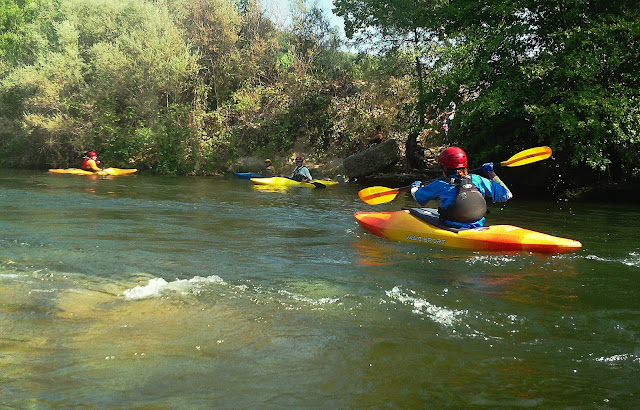Today we stand at the threshold of the unknown. Before us lies a new year, and we are going forward to take possession of it. Who knows what we will find? --L. B. E. Cowman
My friends who have gone down the Grand Canyon say it's truly a life-changing experience. From its breathtaking beauty to its adrenaline-pumping rapids, navigating the canyon is an exhilarating adventure.
“It’s still just reverberating in my brain and coursing through my soul, everything I felt in there,” paddler Steve Baskis told The Colorado Sun, "That place, it changed me. It washed away some things, … and it gave me so much. It tested me, and I came through energized, empowered, revitalized, invigorated., ”Everything you can think of. I want to do it again.”
This past September, Baskis a US Army veteran who was blinded by a roadside bomb in Iraq in 2008, kayaked the Grand Canyon with four other blind veterans with support from Team River Runner.
Think about that. Paddling the Grand Canyon is an amazing achievement in itself, but running it blind is just not just inspiring but extraordinary.
“They kept telling me I took the hero line,” Steve Baskis told The Colorado Sun, “I tell you, I was nervous about this whole thing, but then I got thrown into that washing machine and came out all right. I was like, ‘Wow. Let’s get this thing going!’”
After a breathtaking 12 day and 226 miles journey down the canyon, Bakis and crew emerged transformed.
"It makes you think about life and the different things you can do," Bakis said his interview, "Things really aren’t that impossible. If we can work together, we can figure out a way through anything."
Like the Colorado River, the year 2018, has had its share of both serene flat water and turbulent rapids for me. But, surrounded by my solid foundation of love support and community I have once again been able to ride out those unexpected bumps and challenges and come out all right on the other side.
I'm was so grateful this past year to once again paddle with likes of Dan Crandall, Kim Sprague, John Weed, Paul Camozzi, Thomas Bauman and the rest of the gang at Current Adventures Kayaking School and Trips and The River Store. Any outing with these guys is always a great day on the water.
We gave a sentimental goodbye to Eppies Great Race the area's annual summer celebration, however, added Sly Park Paddle Rentals on Jenkinson Lake to our lineup. In 2019, we're hoping to expand that service even more at its scenic venue. As for kayak racing on the Lower American River, Dan has pledged to somehow keep it going.
One thing leader Greg Weisman and Bayside Adventure Sports can always guarantee at being a guiding light of faith and hope to those who take part in their many outside activities. With the manta, GOD created the Earth. RIDE IT. CLIMB IT. CATCH IT. EXPLORE IT. PROTECT IT, the church-based outreach put a special emphasis on protesting by taking part in several Earth Day events this past year, including a special one of their own. I only hope for many more adventures with them in the coming year.
A big thank you goes out to our 2018's guest bloggers, John D'Amelio,
Lacey Anderson, Tim Plamer, and Kate Hives, for their insights and views this past year. They have certainly make OAM better by providing thoughtful and compelling views into the world of paddling. We certainly look forward to future posts from them in 2019.
I would also like to thank, Dirt Bag Paddlers & DBP Magazine Online, Canoe & Kayak Magazine, Paddling Magazine, AquaBound, American Rivers and NRS Web, for sharing my posts on their social media pages. It's always a fun Friday for me when post Outside Adventure to the Max. Thanks for helping spread the word about our weekly post.
My biggest thanks, of course, goes to my wife Debbie. I couldn't do any of my kayaking without her support and encouragement. Here is hoping she will finally get to stand up on her new paddleboard, after a mostly just be able to sit on it due to a foot injury.
As poet T.S. Eliot wrote, "What we call the beginning is often the end, and to make an end is to make a beginning. The end is where we start from."
I'll finish 2018 with a little over 140 days of paddling days spent on the water, a personal best for me. Broken up mostly into mini outings and weekends trips to my areas' lakes and rivers the year proved to be a never-ending journey of both planned and unanticipated trials and tribulations on the water that took my paddling into a new dimension.
“It’s one thing to pursue challenges," Baskis told The Colorado Sun, after his trip down the fabled canyon,&nfabledut it’s the unexpected challenges that really try us and change us and ultimately make us better. And there were a lot of unexpected things going on in the Grand Canyon.”
That's good advice going into the new year. Be ready for anything. The good and the bad. The stretches of rough water and the calm seas. Outside Adventure to the Max will be with you along the way. Happy New Year.
Follow us on Facebook and Instagram


















































